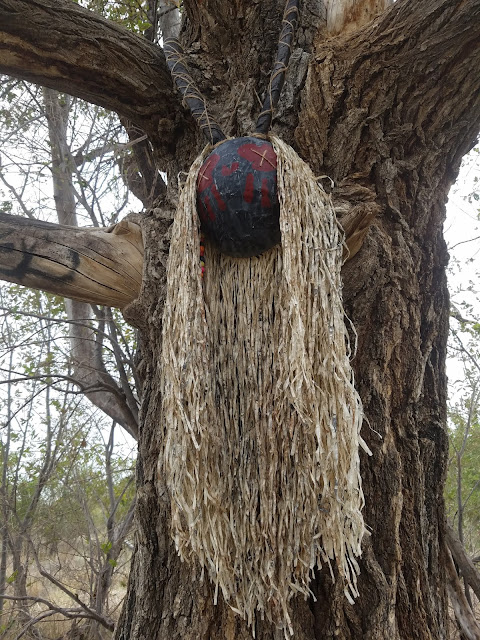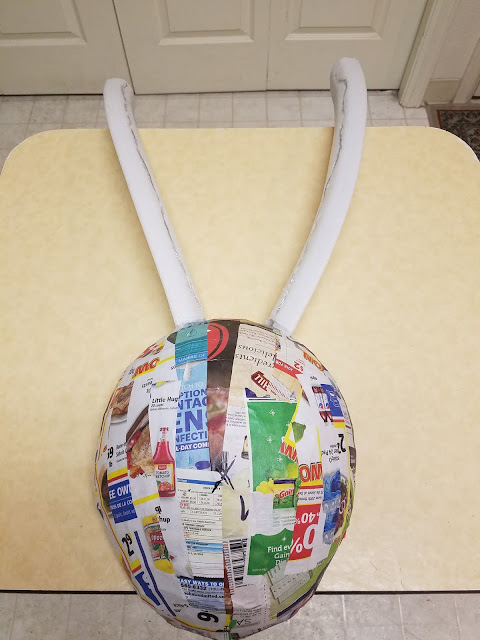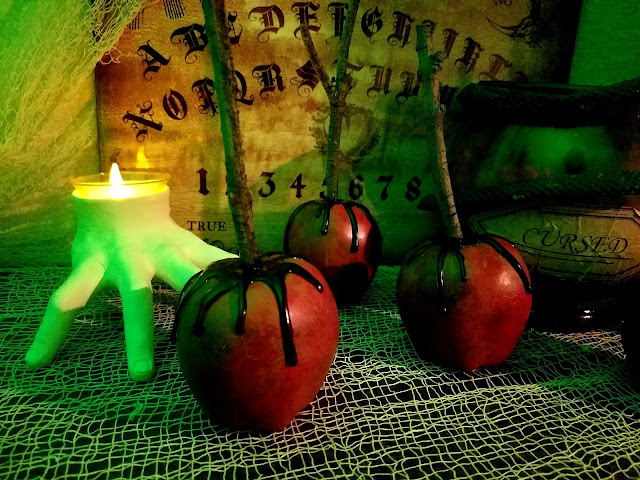$25 - $30 (based on 2018 prices)
Makes one mask
In the summer of 2018, I was asked to make a small collection of props for a theatrical troupe performing a traveling variety show in my town. One of the skits required a cannibal mask for a humors cooking-show segment. I ended up making two versions: one with feathers, which was used for the performances, and one with horns, which was not.
- One large latex balloon
- One roll of painters masking tape
- One 4 oz. bottle of wood glue
- One 4 oz. bottle of all-purpose tacky glue
- One standard-size newspaper
- Two twenty-four-inch foam swords
- Two to three yards of steel wire
- One roll of one-ply, white paper towels
- One 10 oz. can of interior/exterior, fast-drying spray paint in flat black
- One 10 oz. can of interior/exterior, fast-drying spray paint in hammered bronze
- Three to four yards of light brown twine
- One 2 oz. bottle of acrylic paint in flat black*
- One 2 oz. bottle of acrylic paint in flat brown*
- One 2 oz. bottle of acrylic paint in cherry cobbler*
- One 2 oz. bottle of acrylic paint in flat gray*
- One 2 oz. bottle of acrylic paint in flat white*
- Two raffia grass skirts (with a 32” waist and 30” length)
1. Inflate the balloon to your desired size for the mask and use tape to give it a skull-like appearance. You will want to gently wrap the tape around the surface and refrain from pulling strips off and reattaching them, since this will increase your chances of popping the balloon. Once you have attained your chosen look, stand the balloon on a sturdy base.
2. Make the papier mache paste by mixing ½ cup of glue and ½ cup of water in a bowl. Try to use a sealable container. This gives you the ability to store the mixture for a day or two between applications. Also, to give the paste added support, use a combination of all-purpose glue and wood glue (stay away from school glue because it is washable and will dissolve in the water).
3. Cut the newspaper into strips, soak them in the paste, and apply them to the balloon. To make the process more manageable, keep the strips at a reasonable size (mine were roughly six inches long and two inches wide). Similarly, only apply a few layers at a time and allow each layer to completely dry before adding more (I did two layers during each application and let them dry for twenty-four hours). Keep in mind that this prop will be carved and worn. So, you want it as sturdy as possible. A minimum of six to seven layers will suffice, but more is always better.
4. Once you have reached your desired thickness, cut the balloon and remove it from the papier mache shell. Be gentle during this process and gradually work the balloon out.
5. Use a sharp knife to cut the shell in half lengthwise. If it helps, measure and mark your cut first. This will provide you with two separate masks. I used one for this project and the other for the feathered tribal mask which will be featured in a later post.
6. Remove the handles from the foam swords. These will become the horns. I used these particular items because they already possessed the length and general shape that I wanted; however, you can use pool noodles or other foam products and mold them into your desired shapes.
7. Cut steel wire into four seventeen-inch sections and attach them to both sides of the swords. This will provide a wire armature that will allow you to bend the horns and give them more of a curvature.
8. Trim the tops of the swords to give the horns pointed tips and glue them to the mask. I used hot glue, but you can use superglue for a sturdier hold.
9. Tear paper towels into strips and, after soaking them in papier mache paste, cover the horns with one or two layers, creating wrinkles to texture them. If you cannot find one-ply paper towels, simply separate the plies of multi-ply sheets.
10. After the layers have dried, measure and mark the horns into two-inch sections and, using hot glue, create the fluting which naturally occurs as the horns grow over the course of the animal’s life.
11. On a newspaper-lined surface in a well-ventilated area, give the entire prop two even coats of black spray paint and the horns a light dusting of hammered bronze. Although I used two coats, you are free to apply as many coats as you feel necessary.
12. Wrap twine around the horns. I found that starting at the base and working upward works best. Try not to overthink the patterns. A more haphazard design will look more primitive. If you like, you can string wooden beads onto the twine before twisting it around the horns. To help the string remain adhered to the horns, glue portions at various spot, namely around the curves.
13. Water down white acrylic paint and brush it over the mask’s surface, ensuring the liquid settles into all the wrinkles (you can also use a spray bottle for the application). Allow the mixture to sit for a minute and then wipe it clean. You may want to experiment with the consistency prior to doing this: the more water you add, the fainter/lighter the wash; the less water you add, the deeper/darker the wash.
14. Add further detail to the mask by stippling gray paint around the edges and randomly along the surface. You could use a brush with splayed bristles, a stippling sponge, or crumpled paper towels for this application. Also, apply a slight flecking of black paint. You can do this by either quickly flicking a paintbrush or using an old toothbrush and strumming your finger across the bristles. Since this process flings paint everywhere, it’s best to perform it outside.
15. Fashion a face with two bloody handprints. Pour generous amounts of cherry cobbler paint onto the palm of one hand, rub both hands together, and firmly press them against the surface of the mask. It may help to preplan the positioning beforehand, since redoing the application will require repainting the mask.
16. Detail the face by sewing twine on the palms of the bloody handprints to form eyes. Like step twelve, you could string wooden beads onto the twine to add additional interest to the prop.
17. Weather the grass skirts with black and brown paint. If you don’t mind the mess, spread the paint onto the palms of your hands and use your fingers to brush it into the tuffs. Do not worry too much if the strands become matted and tangled during this process (it will only enhance the appearance).
18. Glue the skirts around the inner circumference of the mask and repurpose the draw strings for the skirts as the draw strings for the mask.
19. You could embellish the mask with strands of colorful wooden beads, clusters of feathers, strings of rotten teeth, collections of sea shells, or bunches of severed ears and fingers.
*You will not use the entire bottle’s content for this project.




























